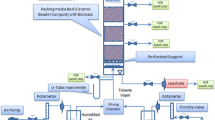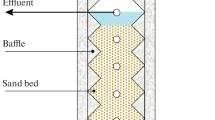Abstract
A trickling filter packed with PVC 16 mm Raschig rings was used to study the degradation of toluene in a polluted air stream, by means of a bacterial biofilm of Pseudomonas putida ATCC 17484. A polluted stream was simulated by blending air with a controlled amount of toluene. The mixing was accomplished in a special mixing chamber designed for that purpose. Induction of the enzymes of the toluene degradative pathway and adaptation of the inoculum were done in batch cultures with minimum mineral media and phenol. The continuous experiments were monitored by mass spectrometry for the quantification of the various gases and of toluene removal. A 94% toluene removal was achieved with contacting times above one minute and toluene concentrations up to 400 ppm.
Similar content being viewed by others
Author information
Authors and Affiliations
Additional information
Received: 11 December 1997
Rights and permissions
About this article
Cite this article
Peixoto, J., Mota, M. Biodegradation of toluene in a trickling filter. Bioprocess Engineering 19, 393–397 (1998). https://doi.org/10.1007/s004490050538
Issue Date:
DOI: https://doi.org/10.1007/s004490050538




